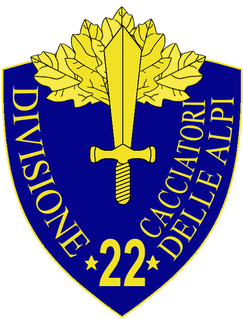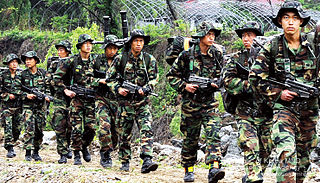Italian war crimes have mainly been associated with Fascist Italy in the Pacification of Libya, the Second Italo-Ethiopian War, and World War II.

The 19th Infantry Division Venezia was a mountain infantry division of the Regio Esercito was raised in 1934 to serve in the Second Italo-Ethiopian War under the name Gavinana division. It was demobilized and reduced to the brigade in July, 1936, but again mobilized 15 April 1939, under the "19th Infantry Division Venezia" name. The only difference between line infantry divisions and mountain infantry divisions was that the latter's artillery was carried by pack mules instead of the standard horse-drawn carriages. Italy's real mountain warfare divisions were the six alpine divisions manned by the "Alpini" mountain troops. In October–November 1943, it has gradually get transformed into the partisan Garibaldi division fighting together with Yugoslav Partisans against Axis.

The 24th Infantry Division Pinerolo was an infantry division of the Italian Army during World War II.

The 36th Infantry Division Forlì was a mountain infantry Division of the Italian Army during World War II. The division was formed as infantry division 31 March 1939, from the men mostly taken from the infantry brigade Monferrato. The men that formed this division were drafted in the Langhe, a geographical region in southern Piedmont. The only difference between line infantry divisions and mountain infantry divisions was that the latter's artillery was carried by pack mules instead of the standard horse-drawn carriages. Italy's real mountain warfare divisions were the six alpine divisions manned by the "Alpini" mountain troops.

The 6th Infantry Division Cuneo was an infantry division of the Italian Army during World War II. The Division was formed 24 May 1939 in Milan city, largely from the parts of 58th Infantry Division Legnano. Cuneo division was part of the III Corps, First Army that took part in the Italian invasion of France and the 26th Corps during Greco-Italian War.

The 12th Infantry Division Sassari was an Infantry Division of the Italian Army during World War II. After the end of World War I the Italian Army disbanded all brigades raised during the war with the exception of the Sassari Infantry Brigade and three further brigades, which also had distinguished themselves during the war: Liguria, Arezzo and Avellino. The brigade moved to Trieste as part of the 12th Infantry Division Timavo'. In 1926 the brigade gained the 12th Infantry Regiment Casale and changed its name to XII Infantry Brigade. Along with the 34th Artillery Regiment the brigade were the only units of the 12th Division. In 1939 the brigade lost the 12th Infantry regiment and was renamed 12th Infantry Division Sassari. This binary division consisted of only two infantry regiments and the 34th Field Artillery Regiment. To increase the weak strength of the division in 1941 the division was joined by the 73rd Blackshirt Assault Legion Boiardo, a battalion sized militia unit of the Italian Fascist Party.

The 13th Infantry Division Re ("King") was an Infantry Division of the Italian Army during World War II. The Re Division was mobilized in June 1940 in Friuli

The 14th Infantry Division Isonzo was an infantry division of the Italian Army during World War II. The division was formed 24 May 1939. It surrendered to German forces on 11 September 1943.

The 15th Infantry Division Bergamo was an infantry division of the Italian Army during World War II. It was formed 24 May 1939 in Opatija.

The 18th Infantry Division Messina was an infantry division of the Italian Army during World War II. It was formed 24 May 1939 in the Fano area on the Italian Adriatic sea coast and was dissolved by Germans 13 September 1943 in Croatia.

The 21st Infantry Division Granatieri di Sardegna was an infantry division of the Italian Army during World War II. The Granatieri di Sardegna Division can trace its origins to 1659 when the Duke Carlo Emanuele II of Savoy formed a regiment of Guards. It became a unit in the national army in 1866.

The 22nd Infantry Division Cacciatori delle Alpi was an infantry division of the Italian Army during World War II. The Cacciatori delle Alpi was mobilized for war in June 1939 and was dissolved 11 September 1943.

The 23rd Infantry Division Ferrara was a mountain infantry division of the Italian Army during World War II. It was formed as division Murgia 28 March 1939. The name was changed to Ferrara 24 May 1939. The only difference between line infantry divisions and mountain infantry divisions was that the latter's artillery was carried by pack mules instead of the standard horse-drawn carriages. Italy's real mountain warfare divisions were the six alpine divisions manned by the "Alpini" mountain troops. After the Italian surrender to the Allies in September 1943, the Division surrendered to the Germans. Its men were drafted in Bari and in the Murge.

The 32nd Infantry Division Marche was a mountain infantry division of the Italian Army during World War II. It was formed 22 February 1939 in Conegliano as Division 32a Marche, based on earlier infantry brigade Marche. The only difference between line infantry divisions and mountain infantry divisions was that the latter's artillery was carried by pack mules instead of the standard horse-drawn carriages. Italy's real mountain warfare divisions were the six alpine divisions manned by the "Alpini" mountain troops.

The 61st Infantry Division Sirte was an auto-transportable Infantry Division of the Italian Army during World War II. The Sirte Division was formed 9 May 1937 in Misrata, and destroyed 23 January 1941 east of Tobruk. The Sirte was classified as an auto-transportable division, meaning staff and equipment could be transported on cars and trucks, although not simultaneously.

The 48th Infantry Division Taro was an infantry division of the Italian Army during World War II. It was formed on 12 September 1939 in Catanzaro and ceased to function 8 September 1943 in Toulon.

The 159th Infantry Division Vento was an infantry division of the Italian Army during World War II. The Vento Division was formed in March 1942, as a garrison division. It was stationed on the Yugoslav border and never saw any combat. It was disbanded after the Italian surrender to the Allies in September 1943.

The 57th Infantry Division Lombardia was a regular infantry division of the Italian Army during World War II. It was formed on 24 May 1939 in Pula and disbanded on 8 September 1943.

The 153rd Infantry Division Macerata was an infantry division of the Italian Army during World War II. The Macerata Division was a Garrison Division formed in December 1941. In June 1942, it was transferred to Slovenia and later moved to Croatia in May 1943, where it conducted anti partisan operations. It was located around Delnice in Croatia when it was captured by the German forces following the Italian surrender to the Allies in September 1943.

The 154th Infantry Division Murge was an infantry division of the Italian Army during World War II. The Murge Division was a garrison division formed in April 1942. It was sent to Dalmatia as an occupation force and took part in anti-Partisan operations. It took part in the Battle of the Sutjeska and then had to be withdrawn after suffering heavy losses in fighting with the Partisans. It was disbanded in September 1943, following the Italian surrender to the Allies.
This page is based on this
Wikipedia article Text is available under the
CC BY-SA 4.0 license; additional terms may apply.
Images, videos and audio are available under their respective licenses.

























